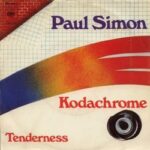 In 1973, Paul Simon released “Kodachrome,” a track that would become one of the defining songs of his solo career, celebrated for its sunny optimism, lyrical wit, and intricate musicality. Known for his reflective and narrative songwriting, Simon crafted “Kodachrome” as both a celebration of life’s colorful moments and a meditation on memory, perception, and the interplay between reality and artifice. The song, featured on his second solo album There Goes Rhymin’ Simon, stands as a testament to his ability to blend storytelling, melody, and cultural commentary into an instantly engaging musical experience.
In 1973, Paul Simon released “Kodachrome,” a track that would become one of the defining songs of his solo career, celebrated for its sunny optimism, lyrical wit, and intricate musicality. Known for his reflective and narrative songwriting, Simon crafted “Kodachrome” as both a celebration of life’s colorful moments and a meditation on memory, perception, and the interplay between reality and artifice. The song, featured on his second solo album There Goes Rhymin’ Simon, stands as a testament to his ability to blend storytelling, melody, and cultural commentary into an instantly engaging musical experience.
“Kodachrome” is named after the iconic Kodak film, a product synonymous with vibrant colors and nostalgia. Simon uses this reference as a vehicle for exploring the way humans capture and process experiences, transforming the song into a meditation on perception, memory, and the human desire to preserve life’s fleeting moments. It is a tune that radiates warmth, optimism, and the playful intelligence for which Paul Simon is celebrated.
Paul Simon: From Folk Roots to Solo Luminary
Paul Simon first rose to prominence as one half of the legendary duo Simon & Garfunkel, whose collaborations like “The Sound of Silence” and “Bridge Over Troubled Water” cemented their place in American music history. After the duo’s split in 1970, Simon embarked on a solo career that allowed him to explore new musical territories, blending folk, pop, and rock with his distinctive lyrical sensibility.
By the time he wrote “Kodachrome,” Simon had already demonstrated a keen ability to merge personal introspection with cultural observation. His solo work embraced more eclectic instrumentation and experimental arrangements while retaining the narrative sophistication that had defined his earlier songwriting. “Kodachrome” exemplifies this balance: it is musically accessible and upbeat while providing subtle, thoughtful commentary beneath its cheerful exterior.
Lyrics: A Celebration of Life in Color
At its core, “Kodachrome” is a song about seeing life vividly, appreciating its colors, and preserving moments that might otherwise fade. The opening lines set the tone with immediacy and charm:
“When I think back on all the crap I learned in high school
It’s a wonder I can think at all
And though my lack of education hasn’t hurt me none
I can read the writing on the wall”
Here, Simon reflects on the absurdities and limitations of formal education, but he does so with humor and a sense of perspective. The lyrics suggest that while the world can be challenging and confusing, it is possible to navigate it with insight, creativity, and resilience.
The chorus, which celebrates the vibrant colors of Kodachrome film, functions as both a literal and metaphorical device:
“Kodachrome
They give us those nice bright colors
Give us the greens of summer
Makes you think all the world’s a sunny day, oh yeah”
Simon transforms the film into a symbol of optimism and vitality. The act of capturing color is akin to preserving joy, highlighting the beauty in everyday moments, and interpreting life through a lens of appreciation and memory. The lyrics balance playful specificity with universal resonance, making the song simultaneously personal and relatable.
Musical Composition and Style
Musically, “Kodachrome” is an exemplar of early-1970s pop-rock, distinguished by its upbeat tempo, catchy melody, and layered instrumentation. The track opens with bright piano chords and a lively rhythm section, establishing a sunlit, buoyant atmosphere. Simon’s vocals are clear and expressive, weaving through the intricate arrangement with ease and warmth.
The song features subtle guitar textures, a driving bassline, and dynamic drumming, all of which contribute to a sound that is polished yet organic. Horn accents and percussive flourishes add depth and vitality, reflecting Simon’s interest in diverse musical elements while maintaining the song’s approachable pop sensibility.
Simon’s songwriting here exemplifies his signature balance of accessibility and sophistication. The melodic structure is immediately engaging, while harmonic shifts and rhythmic variations reward repeated listening, demonstrating the care and craft underlying the seemingly effortless delivery.
Cultural Context and Reception
Released as a single in 1973, “Kodachrome” arrived during a period of American cultural optimism tempered by lingering societal tensions. The Vietnam War was winding down, the Watergate scandal was unfolding, and the country was navigating shifting social and political landscapes. Amid this complexity, Simon offered a song that was both lighthearted and reflective—a reminder to appreciate life’s vibrancy even in uncertain times.
The song was met with immediate commercial success, reaching number two on the Billboard Hot 100 and securing its place as one of Simon’s most recognizable solo tracks. Its success reflected the public’s appetite for music that combined intelligence, humor, and melodic appeal. Over the years, “Kodachrome” has become emblematic of Simon’s skill in crafting pop songs with depth, charm, and enduring relevance.
Themes of Memory, Perception, and Nostalgia
“Kodachrome” is more than a celebration of bright colors; it is a meditation on the way humans perceive and preserve experiences. By invoking the metaphor of photographic film, Simon highlights the selective, interpretive nature of memory. Just as Kodachrome film enhances certain colors while downplaying others, people remember life in ways that amplify joy, downplay pain, and create a curated version of reality.
The song also engages with nostalgia in a playful but sophisticated way. Simon reflects on the past—not with regret, but with humor and insight. Lines that reference high school, education, and personal growth underscore a recognition of life’s imperfections while celebrating the ability to find meaning and beauty despite them. In this way, “Kodachrome” serves as a reminder that perspective, like film, shapes the way life is experienced and remembered.
Production and Sound Aesthetic
Produced by Paul Simon and Phil Ramone, “Kodachrome” benefits from a clean, bright production that mirrors the song’s thematic focus on color and clarity. Each instrument is distinctly audible, yet the arrangement maintains a cohesive warmth that reinforces the sense of joy and vitality.
Simon’s attention to detail in layering instruments, adjusting tonal balance, and crafting dynamic shifts demonstrates his meticulous approach to songwriting and production. The track’s sonic palette—bright pianos, subtle percussion, and tasteful guitar lines—enhances the lyrical content, creating a holistic experience that is both musically satisfying and thematically resonant.
Impact and Legacy
“Kodachrome” has left an indelible mark on popular culture. Beyond its commercial success, the song has inspired artists across genres, from folk and rock to pop and indie music. Its combination of witty, reflective lyrics and upbeat melody exemplifies a model of songwriting that is both approachable and intellectually engaging.
The song’s legacy is also reflected in its enduring presence in media and popular discourse. From inclusion in soundtracks to references in literature and journalism, “Kodachrome” remains a touchstone for discussions of nostalgia, memory, and the interplay between art and perception. Its influence extends beyond music, shaping cultural understandings of how humans interact with memory, experience, and the aesthetic presentation of life.
Live Performances and Audience Connection
Live renditions of “Kodachrome” highlight the song’s infectious energy and audience appeal. Simon’s performances often emphasize the interplay between lyrics and melody, allowing the audience to engage with both the humor and insight embedded in the song. Its singable chorus and uplifting rhythm make it a favorite in concert settings, encouraging communal participation and reinforcing the song’s celebratory tone.
Audiences consistently respond to “Kodachrome” not just for its catchy hooks, but for its ability to evoke reflection, joy, and shared nostalgia. The song’s blend of personal insight and universal appeal makes it a rare track that resonates across demographics, generations, and cultural contexts.
Why ‘Kodachrome’ Endures
The lasting appeal of “Kodachrome” lies in its ability to balance playfulness, optimism, and intellectual engagement. It is both immediately accessible and rich with nuance, allowing listeners to enjoy it as a catchy pop tune while also appreciating its deeper thematic explorations.
Simon’s songwriting brilliance is evident in the song’s layered structure: the lyrics provide humor and insight, the melody invites engagement, and the instrumentation creates a sense of light, color, and vibrancy. Together, these elements form a track that transcends its era, remaining relevant and inspiring decades after its initial release.
Conclusion: A Sunlit Anthem of Memory and Joy
Paul Simon’s “Kodachrome” endures as a shining example of songwriting that is clever, melodic, and culturally resonant. By celebrating color, memory, and the whimsical nature of perception, the song captures a sense of joy and optimism that transcends time. Its infectious melody, witty lyrics, and thoughtful production make it both entertaining and meaningful—a rare combination that ensures its lasting place in the musical canon.
Through “Kodachrome,” Simon reminds listeners that life’s vibrancy is worth noticing, capturing, and celebrating. Whether experienced as a nostalgic reflection, a commentary on perception, or simply an enjoyable pop-rock track, the song continues to resonate with audiences worldwide.
With its bright energy, clever lyrics, and timeless charm, ‘Kodachrome’ stands as a testament to Paul Simon’s artistry—a musical celebration of memory, color, and the joy of seeing life in all its vivid detail.


